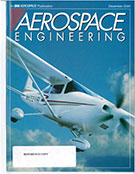Magazine

Aerospace Engineering & Manufacturing 2008-12-01
2008-12-01
From part to plane: the fastest machine wins Next-gen machining centers and controllers brings new precision and capabilities to both metal and composite manufacturing. Files moved around the world As aircraft manufacturers distribute more jobs to contractors, streamlining the transfer of information has become an important part of both design and manufacturing. Top technologies of 2008 A look back at some of the most significant technological innovations during the past year. VLJ power Some engine programs for very light jets are full swing while certification awaits others.



















